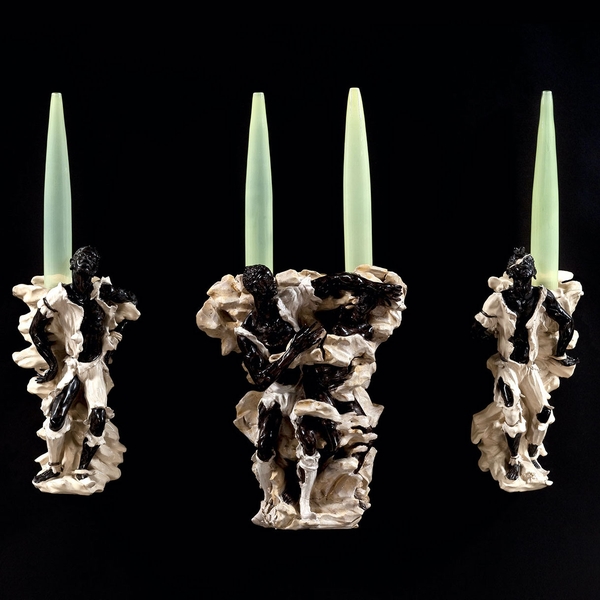
Three ceramic wall lights depicting the Schiavoni. Sulphur blown glass diffusers, Venini.
The central group 56×27×12 cm, the two singles 50×16×8 cm and 50×16×11 cm
Fabrizio Clerici is one of the leading figures in Italian art of the 20th century, a refined painter, set designer, and incomparable illustrator in his capacity for visionary and limitless inventiveness. An extremely knowledgeable artist with encyclopedic curiosity, he gave life to dreamlike and enigmatic universes, rich in charm, stemming from boundless imagination nourished by classical culture and mythology, as well as the movements of his subconscious.
In 1948, he was commissioned to completely renovate in Venice the palace next to the Basilica della Salute for Countess Anna Maria Cicogna Volpi. The work continued until 1952 due to Clerici's meticulous attention to every decorative element of the house, for which he provided the designs. For the stucco work, he entrusted the brilliant German painter Fabius von Gugel, and the sculptor Andrea Spadini was responsible for creating the majolica busts depicting stork hunters and the stone caryatids that adorned the garden. The rooms of the Cicogna Volpi palace were illuminated by ceramic wall sconces with fantastic iconography: grapevines, carnival boots, Oriental figures, and depictions of chained Moors, inspired by a model by Longhena for the Pesaro monument in the Basilica dei Frari. Clerici himself is portrayed, alongside his friend Leonor Fini, embodying the four seasons. The cone-shaped diffusers with ethereal colors were blown in the glass factory of Paolo Venini in Murano.
Three ceramic wall lights depicting the Schiavoni. Sulphur blown glass diffusers, Venini.
The central group 56×27×12 cm, the two singles 50×16×8 cm and 50×16×11 cm
Fabrizio Clerici is one of the leading figures in Italian art of the 20th century, a refined painter, set designer, and incomparable illustrator in his capacity for visionary and limitless inventiveness. An extremely knowledgeable artist with encyclopedic curiosity, he gave life to dreamlike and enigmatic universes, rich in charm, stemming from boundless imagination nourished by classical culture and mythology, as well as the movements of his subconscious.
In 1948, he was commissioned to completely renovate in Venice the palace next to the Basilica della Salute for Countess Anna Maria Cicogna Volpi. The work continued until 1952 due to Clerici's meticulous attention to every decorative element of the house, for which he provided the designs. For the stucco work, he entrusted the brilliant German painter Fabius von Gugel, and the sculptor Andrea Spadini was responsible for creating the majolica busts depicting stork hunters and the stone caryatids that adorned the garden. The rooms of the Cicogna Volpi palace were illuminated by ceramic wall sconces with fantastic iconography: grapevines, carnival boots, Oriental figures, and depictions of chained Moors, inspired by a model by Longhena for the Pesaro monument in the Basilica dei Frari. Clerici himself is portrayed, alongside his friend Leonor Fini, embodying the four seasons. The cone-shaped diffusers with ethereal colors were blown in the glass factory of Paolo Venini in Murano.

